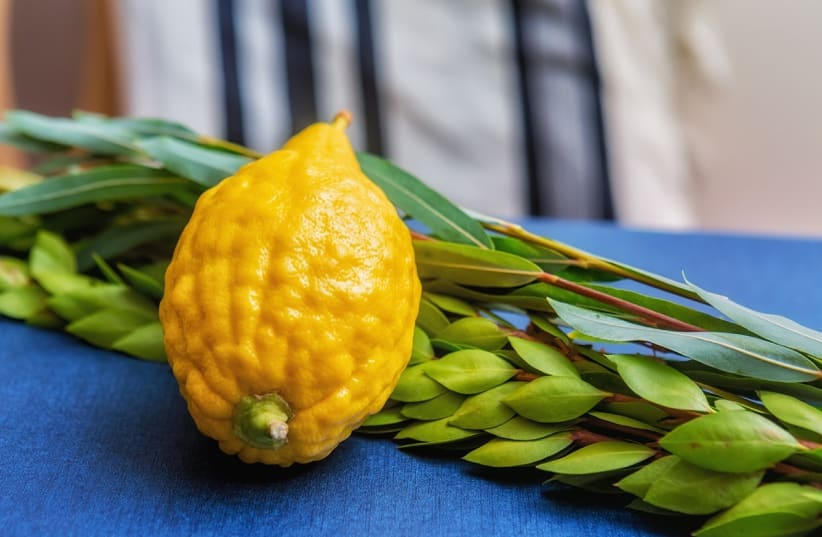If you have never heard of an “etroger,” a Yiddish term for a Jewish merchant who sold citrons to Jewish communities in central and northern Europe during the Middle Ages and beyond, you are not alone. Joshua Teplitsky, an associate professor of Jewish history at the University of Pennsylvania, was not familiar with the term, either. When he came across mention of an etroger in his research on a book about the chief rabbi of Prague, he was compelled to learn more.
The thick-skinned citron is required for various rituals during the harvest holiday of Sukkot (which starts this year tonight at sundown and runs through Friday, Oct. 6). The fruit hails from tropical and sub-tropical climes; procuring and distributing them in the pre-Industrial era would not have been a simple task.
Together with Warren Klein, the curator of the Bernard Museum of Judaica at Temple Emanu-El, and Sharon Liberman Mintz, curator of Jewish art at the library of the Jewish Theological Seminary, Teplitsky did a deep dive into the etrog.
“My ancestors came from Eastern Europe. How would they have procured an etrog for the holiday?” Klein told the New York Jewish Week. Learning about the etroger “was an amazing ‘aha’ moment. It makes so much sense.”
The trio’s probing into the history, use, care, dissemination, and symbolism of the etrog culminated in a book, “Be Fruitful: The Etrog in Jewish Art, Culture and History” that was published in 2022. From that research was born the exhibit, “Etrog, The Wandering Fruit,” currently on display at the Bernard Museum, located inside Temple Emanu-El on 5th Avenue and 65th Street in Manhattan.
First museum devoted to etrogs
According to Klein, this is the first-ever museum exhibit devoted solely to the story of this citrus, which is depicted in ancient Jewish artifacts. “We spent most of COVID editing the volume, and the idea was to turn the research into this exhibition,” Klein said. “It was too visual and too good not to educate the world.”
The three scholars gathered other scholars, curators, collectors, and artists to create a 360-degree study of the etrog: from its origins in China, its distribution across the globe by Persian merchants, its seminal role in the harvest holiday of Sukkot and how it came to be associated with the Temple in Jerusalem and the Land of Israel.
The exhibit includes early depictions and mentions of the etrog in a variety of sources and objects, including bronze coins minted at the time of the destruction of the Second Temple in Jerusalem in 70 CE, which are stamped with a likeness of the fruit, and mosaic inlays from a synagogue floor in Tiberias, Israel that dates between the 6th and 8th centuries CE.
The more than 100 examples of etrog-related ephemera come from 20 different lenders, both public and private, including the Jewish Museum, the New York Botanical Garden Library and the American Numismatic Society. In addition to etrog containers, and documents about the etroger, there are illuminated pages — originals and facsimiles — in which the etrog appears.
“The facsimile of the Rothschild Miscellany is the most special — it is the most beautiful Hebrew manuscript ever created,” Mintz said. According to UNESCO, the ornate manuscript from Northern Italy, which dates to the 15th century, offers “a rare window into the religious customs, daily lives and fashion of Italian Renaissance.” At the museum, the Rothschild Miscellany page on display shows a white-bearded man, his head covered in a prayer shawl, holding a bumpy etrog in his left hand with the lulav, consisting of a frond of a date palm tree, willow and myrtle, in his other. (Together, these items are known as the four species, which represent the four-letter Name of God, among other things, and are a key feature of Sukkot.)
On display, too, are boxes designed to hold the fruit, which range from ornate to simple. “The etrog box becomes a microcosm: You can see how Jews created objects to beautify the holiday and ritual,” Mintz said. “In every place where an etrog box is created, it will reflect a time and place of the art and the aesthetics of the Jews at that moment.”
Some of the etrog containers were household items that were repurposed, like an 18th-19th century sugar box from Germany or a mustard pot owned by a Sephardic merchant living in Colonial New York. “When you come to the modern era, all of a sudden artists are using the latest art nouveau aesthetic,” Mintz said. “It is a wonderful way to look at Jewish art.”
Also on display are modern iterations of the etrog box. British silversmith Mila Tanya Griebel created a silver box with cutouts, allowing people to both see the etrog and smell its sweet aroma. Fiber artist Rachel Kanter created a pouch that a woman might take with her to synagogue; one could wrap the etrog in the fabric, which is helpfully printed with a recipe for etrog preserves. New York-based Judaica artist Tobi Kahn created a painted wood box that is, according to Klein,”the perfect shape to take with him to shul. He can place it under his arm and still hold his grandchildren’s hands.”
Though the scholars are pleased with the exhibition — which is on view until Nov. 20 — if they were to do it all over again, they said they’d probably include a section about the “afterlife” of the etrog.
“We wanted to think about the etrog’s use in recipes — jam or baking — once the chag is over, how did people engage with the etrog,” Teplitsky said. “One chapter in the book explores the etrog in medical recipes. There is evidence from the Cairo Genizah of the etrog being used for medicinal uses, kidney stones, curing bad breath and easing the pains of childbirth.”

